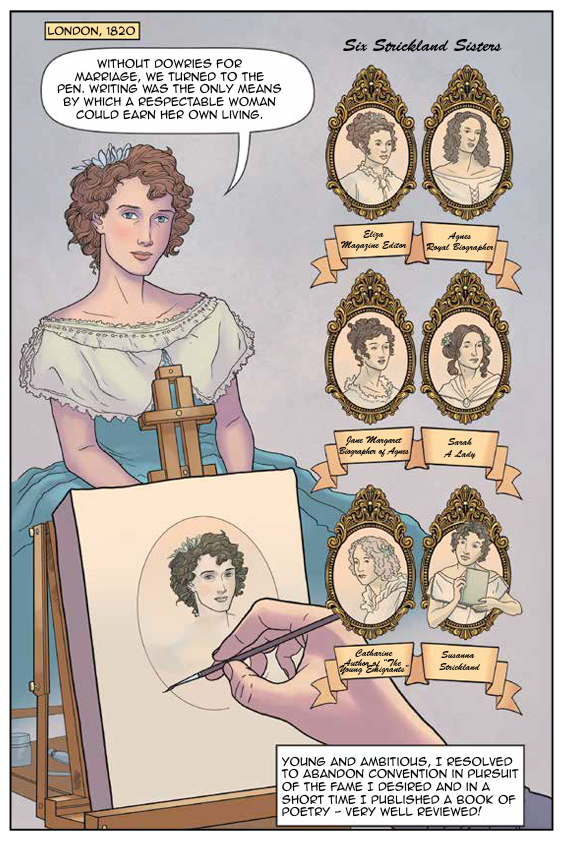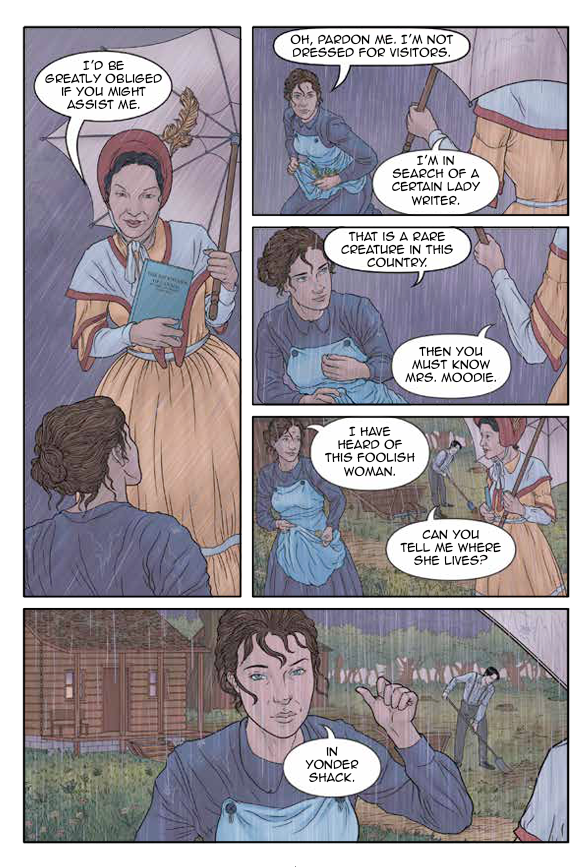ljrinaldi's review against another edition
4.0
I will start by saying that I have never heard of Susanna Moodie, but then I have not read nearly enough Canadian history. This shows me that I really should. I saw that Margaret Atwood had written the introduction, but I decided I needed no introduction, so plunged right into it.
Going in cold, without any background of Canadian history made this all the more intriguing. Susanna was born an aristocrat in the early part of the 19th century, int he UK. When her father dies, she has no money for a dowery, so must find a suiter who does not care about such things.. She, like most of the upper class, was not taught to take care of herself, or any domestic duties. She wanted to write, and did so. She ends up marrying a retired military officer, but finds that his pay will not support her, so decide to move to Canada, because it is cheaper there. She and her husband are not told that they are really moving into the wilderness, and they will have to do everything early settlers have to do for themselves.
And example of the protagonist at the beginning of the story.

And how she looks after she have moved to the "bush", and lived there for a while:

This reminds me a little bit of The First Four Years, but Laura Engles Wilder, but Laura grew up in the wilderness, and did know how to do things, like milk cows, and bake bread. Susanna had no clue how to cook, or do any of these things. And she has to learn, and learn quickly. She does make friends with the local First Nation people, as well as a man of color, who sells her a cow, so she can have milk.
Life is not easy, but Susanna goes into it determined, and it is an interesting transformation. The story follows her life from when she is a young woman to when she is an elderly woman. Through it all she has a sense of humor, and strives on.
Apparently, according to the prolog of the book, this was originally going to be a movie, but it never got made. And once I read that, and saw Margaret Atwood mentioned again, I decided to read the introduction, and learned how important Susanna Moodie was to Margaret, and why she wrote a poem about her, and how others have brought her up in their works.
I really enjoyed reading this. It makes me want to read the original book. It makes me want to read more about Canadian History. It makes me realize how ignorant I am of women writers in the 19th century.
I would highly recommend this book to anyone who is interested in Canadian History, interested in Women's history, interested in writings about what it was really like to live in the bush.
My only problem with this book, and the reason it does not get the final star is that the illustrations sometimes go "off-model" and look wrong, or the poses would look ackward. It is a minor thing, but bugged me.
Thanks to Netgalley for making this book available for an honest review.
Going in cold, without any background of Canadian history made this all the more intriguing. Susanna was born an aristocrat in the early part of the 19th century, int he UK. When her father dies, she has no money for a dowery, so must find a suiter who does not care about such things.. She, like most of the upper class, was not taught to take care of herself, or any domestic duties. She wanted to write, and did so. She ends up marrying a retired military officer, but finds that his pay will not support her, so decide to move to Canada, because it is cheaper there. She and her husband are not told that they are really moving into the wilderness, and they will have to do everything early settlers have to do for themselves.
And example of the protagonist at the beginning of the story.

And how she looks after she have moved to the "bush", and lived there for a while:

This reminds me a little bit of The First Four Years, but Laura Engles Wilder, but Laura grew up in the wilderness, and did know how to do things, like milk cows, and bake bread. Susanna had no clue how to cook, or do any of these things. And she has to learn, and learn quickly. She does make friends with the local First Nation people, as well as a man of color, who sells her a cow, so she can have milk.
Life is not easy, but Susanna goes into it determined, and it is an interesting transformation. The story follows her life from when she is a young woman to when she is an elderly woman. Through it all she has a sense of humor, and strives on.
Apparently, according to the prolog of the book, this was originally going to be a movie, but it never got made. And once I read that, and saw Margaret Atwood mentioned again, I decided to read the introduction, and learned how important Susanna Moodie was to Margaret, and why she wrote a poem about her, and how others have brought her up in their works.
I really enjoyed reading this. It makes me want to read the original book. It makes me want to read more about Canadian History. It makes me realize how ignorant I am of women writers in the 19th century.
I would highly recommend this book to anyone who is interested in Canadian History, interested in Women's history, interested in writings about what it was really like to live in the bush.
My only problem with this book, and the reason it does not get the final star is that the illustrations sometimes go "off-model" and look wrong, or the poses would look ackward. It is a minor thing, but bugged me.
Thanks to Netgalley for making this book available for an honest review.
grauspitz's review against another edition
4.0
A really good introduction to Susanna Moodie for those who find the original novel to be intimidating.
Or if you're like me, a quick introduction as this came in from the library before the original did. And while I can't see myself reading this again, I still think it's very important to have accessible classics, especially Canadian classics that might not otherwise be read.
Or if you're like me, a quick introduction as this came in from the library before the original did. And while I can't see myself reading this again, I still think it's very important to have accessible classics, especially Canadian classics that might not otherwise be read.
erine's review against another edition
4.0
This cross between Jane Austen and Laura Ingalls Wilder makes for another fascinating woman. I would be keenly interested to read Susanna Moodie's actual work.
chessakat's review
5.0
I loved this! I had never heard of Susanna Moodie before coming across this book in the NetGalley bookshelves for Comics & Graphic Novels - but I'm so glad I found her! This is a fascinating slice of life on a subject I know literally nothing about - the settling of Canada. Susanna grew up fairly well-off in England, but by the time her and her many sisters were of age, their wealth had declined to the point that all the sisters took to writing for a living. After meeting her future husband at a party, they decide their best course of action was to go abroad and settle in Canada. But they were led to believe the land they were moving to was *much* further along in its settlement. This is the story of coming to terms with reality crashing headlong into mistaken expectations.
It is extremely well done. The art really lends itself to revealing the emotions - the loneliness, despair, exhaustion from hard labor - so much is conveyed in one panel. Even though there are many grim moments in the story, you still come away with a sense that this was a woman with a lot of pluck - she put one foot in front of the other and got what needed doing DONE and kept her family alive despite all odds.
I'm feeling particularly grateful for my warm house with food in the pantry after reading this bite of graphic history.
Recommended highly to anyone who enjoys a story of a woman with grit, who is curious about settling the Canadian "bush" in the early 1800s, or who just enjoys history via graphic novel.
It is extremely well done. The art really lends itself to revealing the emotions - the loneliness, despair, exhaustion from hard labor - so much is conveyed in one panel. Even though there are many grim moments in the story, you still come away with a sense that this was a woman with a lot of pluck - she put one foot in front of the other and got what needed doing DONE and kept her family alive despite all odds.
I'm feeling particularly grateful for my warm house with food in the pantry after reading this bite of graphic history.
Recommended highly to anyone who enjoys a story of a woman with grit, who is curious about settling the Canadian "bush" in the early 1800s, or who just enjoys history via graphic novel.
More...